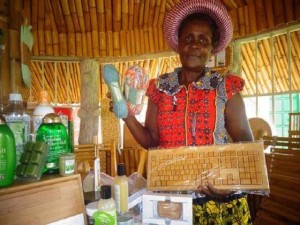 Sitting on more than 10 acres, Nyabera Farm in Uriri, Migori County, hosts an assortment of crops that include collard greens (sukuma wiki), cabbages, watermelon, tomatoes, pumpkins and bamboo.
Sitting on more than 10 acres, Nyabera Farm in Uriri, Migori County, hosts an assortment of crops that include collard greens (sukuma wiki), cabbages, watermelon, tomatoes, pumpkins and bamboo.
But it is on the bamboo farm that the owner of Nyabera Farm, Francisca Kwasa, is stirring a revolution.
Francisca grows thousands of bamboo seedlings inside two greenhouses measuring 8 by 15 metres each. She produces a portfolio of items made from bamboo that she grows in her farm. She has constructed a small ‘museum’ at her home where she archives and displays diverse varieties of products from body lotions to hair gel, clothes, colognes, computer keyboards, furniture to floor tiles, among others.
“I have more than 60,000 bamboo seedlings of eight different varieties that include Bambusa vulgaris, Bambusa tulda and Dendrocalamus giganteus, which I grow for sale. They go for between Sh300 and Sh800,” says Francisca, adding that her prices are higher as compared to the Sh100 in the market because of the environment she raises them.
She does all the propagation process inside the greenhouse.
From one culm, which costs her Sh30, she extracts seven cuttings or buds.
“To get a bamboo seedling, the culm is chopped into several buds, then a hole is punched on each bud. It is then lightly covered with some soil on the ground before being watered and left to sprout. Water is poured inside the hollow buds to hasten germination of shoots,” she explains.
“After the shoots grow four to five leaves, they are split into individual plants before I transfer them into portable plastic bags.”
The seedlings stay inside the greenhouse for a month and are then transferred outside where they stay for two months hardening before being sold.
“A three to four-month-old seedlings goes for Sh300 while an ornamental seedling of the same age goes at Sh800,” she says.
Bamboo seedlings grown inside the structure are ready for sale in four months and not six as the others grown outside. The crop, however, matures in four years.
Francisca has taken bamboo farming a notch higher by constructing a small “museum” at her home where she archives and displays diverse varieties of products from body lotions to hair gel, clothes, colognes, computer keyboards, furniture to floor tiles, among many more.
Controlled Environment
Young shoots of giant bamboo varieties are also a delicacy. In Mt Elgon, residents harvest two-week-old bamboo shoots and chew them, with scientists noting the crop strengthens the immune system and burns cholesterol.
“I spent close to Sh2 million to go into bamboo farming and it was by chance after meeting a man selling seedlings who enlightened me about the benefit of growing the grass,” says Francisca, whose farm hosted World Bamboo Day celebrations last year.
The former administrator at the United Nations started the bamboo venture in 2015 with her husband.
“Then we were looking for a crop that did not need constant checking and bamboo was perfect for us,” says Francisca, who sells the plants to local farmers, landscaping designers and county governments.
Dr Robert Nyambati, the Kenya Forestry Research Institute (Kefri) Regional Director in-charge of Lake Victoria Basin Eco-region Research Programme, says raising bamboo seedlings inside greenhouses is more efficient.
“Greenhouse environment is controlled, thus, it helps in development of the plant’s roots, which is usually a big challenge.”
Kefri has done a lot of research on bamboo, including where which variety can perform better and urges farmers to consult them for training and seedlings.
“Bamboo helps to heal the environment. If planted along the rivers, it can reduce erosion and conserve water points,” says Paul Ongugo, a research scientist at Kefri.
Source: Daily Nation. Photo courtesy: LEOPOLD OBI | NATION MEDIA GROUP
